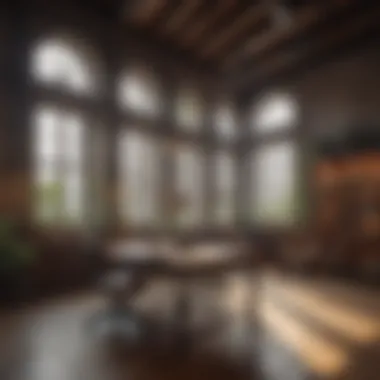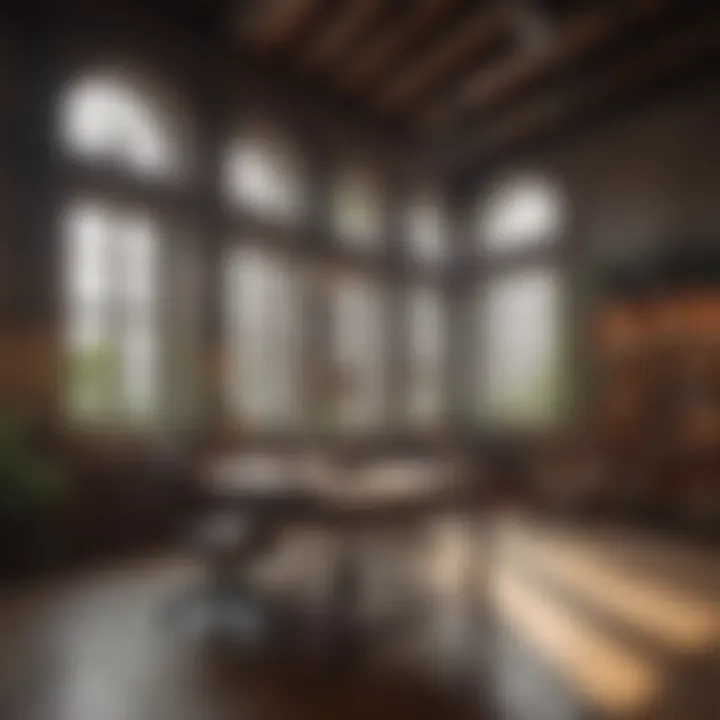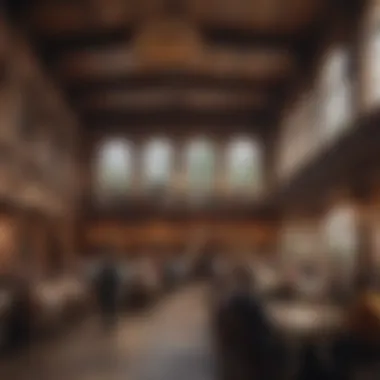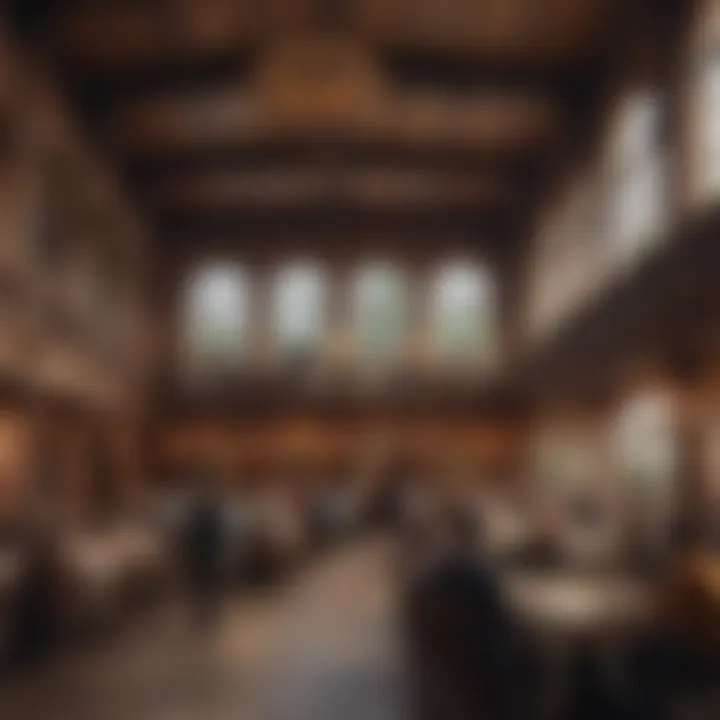Exploring the Market of Old Buildings for Rent


Intro
The market for old buildings offers a unique blend of historical character and modern utility. More than mere structures, these buildings encapsulate stories of the past, reflecting rich architectural styles and cultural significance. This trend of renting old buildings is not just driven by nostalgia, but also by a desire for distinctive living and working environments that contemporary constructions often lack.
In examining this market, several factors emerge. From aesthetic appeal to potential financial benefits, there are compelling reasons renters opt for historical edifices. Understanding this dynamic is crucial for various stakeholders, including real estate enthusiasts, architects, and individuals looking for rental properties that stand apart from typical options.
Home Design Inspiration
Old buildings possess a unique charm that can inspire various design approaches. The diverse architectural styles found in these structures can serve as a foundation for innovative interior design.
Architectural Styles
The architectural styles of old buildings span several periods and influences. Common styles include:
- Gothic Revival: Characterized by pointed arches and intricate stone detailing, this style adds a sense of history and grandeur.
- Victorian: Known for its ornate details and vibrant colors, Victorian architecture often includes turrets and decorative trim features.
- Mid-Century Modern: Though more recent, buildings from this era emphasize simplicity and integration with nature, appealing to those who value minimalism.
These styles not only inform interior design but also the overall feel of a property. An understanding of these architectural details can enhance the living experience and personal expression through decor choices.
Innovative Decor Trends
As renters seek to personalize their spaces, they often turn to innovative decor trends that complement the historical essence of old buildings. Some popular trends include:
- Upcycled Materials: Utilizing reclaimed wood and vintage furnishings promotes sustainability while adding character.
- Industrial Chic: This style emphasizes raw materials and open spaces, creating a modern yet nostalgic atmosphere.
- Eclectic Mix: Combining various decor elements from different eras allows for personal expression, making the space feel unique and lived-in.
Incorporating these trends not only enhances the aesthetic but can also facilitate a deeper connection to the building’s heritage. Such decor approaches make the old feel new while honoring its past.
Stunning Locations
The allure of renting old buildings is amplified by their location. Importantly, some regions have become hubs for such architectural gems, attracting diverse tenant demographics.
Top Global Destinations
Cities known for their historical significance often feature an array of old buildings available for rent. These include:
- Rome, Italy: The city's ancient architecture offers countless opportunities to inhabit history.
- Paris, France: With its charming Haussmannian buildings, Paris provides a romantic backdrop for renters.
- New Orleans, USA: Known for its eclectic Creole cottages and Victorian mansions, this city embodies a rich cultural tapestry.
Hidden Gems Around the World
Beyond well-trodden tourist paths, lesser-known locations also boast fascinating old buildings suitable for residential or business use. Here are a few:
- Tallinn, Estonia: Its medieval old town features beautifully preserved Hanseatic architecture.
- Ghent, Belgium: The historic center is full of old buildings that house modern businesses adopting unique aesthetic standards.
- Havana, Cuba: The vibrant, colorful colonial architecture offers an engaging atmosphere for residents and visitors alike.
These locations showcase how renting old buildings can extend beyond mere accommodation, offering cultural immersion and a rich sense of place.
Embracing the market of old buildings for rent invites both opportunities and challenges. A thorough understanding of aspects like historical significance, decor trends, and geographical context is essential to appreciate their full potential.
Preamble to Old Buildings for Rent
Renting old buildings represents a unique intersection of heritage and modern living. This trend is increasingly marked by interest from a diverse range of renters, including individuals, creative companies, and various enterprises. The charm and history embedded in these structures attract a multitude of tenants seeking more than just functional spaces—they desire environments that tell stories and evoke emotions. These sentiments are becoming essential in today's real estate landscape, where aesthetic appeal holds significance alongside practical utility.
Several considerations come into play when exploring this market. Firstly, the architectural uniqueness of old buildings often serves as a major selling point. Each building typically possesses distinct characteristics linked to its era, reflecting the styles and values of the time. Secondly, the location of these properties is often strategic, situated in areas rich with culture and community engagement. Moreover, a sense of nostalgia and identity resonates throughout these spaces, appealing to those who appreciate history.
However, the decision to rent an old building is not without its complexities. Potential renters must think about maintenance issues, regulatory restrictions, and the potential expenses related to restoration and upkeep. These challenges can be daunting, yet for many, the benefits outweigh the drawbacks. The essence of history infused in daily life can provide a rewarding experience. It is not just about finding a place to live or work; it's about embracing a unique lifestyle that incorporates elements of the past.
"Old buildings hold stories waiting to be told, fostering creativity and connection within their walls."
This section lays the groundwork for understanding the numerous facets contributing to the increasing allure of old buildings for rent. The following subsections will discuss the definitions and characteristics that define this niche market, further enhancing the read.
Definition and Characteristics
Old buildings, commonly referred to as historic or heritage properties, are not just real estate assets; they are embodiments of the past, enriched with cultural and architectural significances. Generally, an old building can be classified as a structure that is at least several decades old, often coming from specific historical periods that are recognized for their architectural styles and societal contexts.
The characteristics of such buildings can vary widely, yet many share common features:
- Architectural Styles: You might find Gothic, Victorian, Revivalist, or Art Deco influences, among others, resulting in unique façades, intricate moldings, and stunning embellishments.
- Materials and Craftsmanship: Older buildings typically utilize traditional building materials such as stone, wood, and brick. The craftsmanship that goes into these details is often much more pronounced compared to more modern properties.
- Layout and Proportions: These buildings usually display unique layouts, with high ceilings, larger windows, and customized spaces that evoke a certain majesty missing in newer construction.
In summary, old buildings for rent are characterized by their rich history, unique architectural elements, and significance in their respective communities. The blend of aesthetics and narrative contributes to their desirability, making them compelling choices for both living and working environments.
Historical Significance of Old Buildings
The historical significance of old buildings cannot be overstated. They tell the stories of past eras, reflecting the socio-economic conditions, artistic movements, and technological advances of their time. In this article, we will delve into the important elements that illustrate why old buildings are valuable not just as rental properties, but as cultural artifacts worthy of preservation.
Architectural Styles and Eras
Each old building represents a unique architectural style that corresponds to a specific era. For instance, Victorian structures often showcase intricate decorative details, while mid-century modern designs focus on simplicity and functionality. Understanding these styles gives renters insights into the design aesthetics of their chosen space.


These styles differ globally, providing a rich tapestry of experiences. For example, the Gothic Revival period emphasizes height and grandeur, creating awe-inspiring cathedrals, while the Arts and Crafts movement focused on natural materials and handcrafted detail, promoting sustainability.
Additionally, the era in which a building was constructed also defines its historical importance. From classical Roman architecture to iconic 20th-century skyscrapers, each building embodies the innovations and values of its time.
Cultural Value and Preservation
Beyond their architectural beauty, old buildings hold immense cultural value. They serve as physical reminders of historical events and societal changes. For many communities, they are central to local identity and create a sense of continuity through time. The preservation of these buildings helps maintain this identity, offering a tangible connection to the past.
Preservation efforts can face challenges. Financial constraints often limit the ability to maintain these structures, making it crucial for local governments and communities to prioritize their protection. This can involve establishing regulations to prevent deterioration and encourage restoration using authentic materials and techniques.
"Old buildings are not just stories; they are artifacts that carry the weight of history within their walls."
Current Trends in Renting Old Buildings
The trend of renting old buildings is gaining significant momentum. This shift is influenced by several factors, ranging from changing societal values to a growing appreciation for architectural heritage. As more people seek unique living and working spaces, the allure of historical structures becomes increasingly evident. The following sections will delineate key trends that shape the current market for old building rentals, as well as their implications for tenants and property owners alike.
Rise in Popularity Among Renters
In recent years, there has been a marked increase in demand for rental spaces in old buildings. Many renters are motivated by the distinct character found in these properties. Such buildings often present unique design elements that are absent in contemporary constructions. The charm of exposed brick walls, original wood flooring, and intricate moldings cannot be replicated in new developments. This appeal resonates particularly with millennials and younger renters, who value experiences and aesthetics highly.
Moreover, as cities expand, housing shortages become common. This phenomenon drives prospective tenants to explore unconventional options, including the rental of historical properties. They often find these spaces to be more spacious and affordable compared to newer units. Therefore, old buildings can provide not only a unique aesthetic but also practical advantages in urban areas.
"Renting an old building often embodies a lifestyle choice that prioritizes character and charm, appealing to those fatigued by uniformity in modern architecture."
Corporate Use and Creative Spaces
The rise in remote work and freelancing has further propelled interest in renting old buildings. Many businesses are now seeking out unique locations that foster creativity and brand identity. Old warehouses, factories, and historic homes are evolving into vibrant offices and creative hubs. Following the COVID-19 pandemic, many companies have opted to move away from sterile office environments. They look for inspiring settings that encourage collaboration and innovation.
For creative agencies and startups, renting old buildings can create a more stimulating work atmosphere. Such spaces allow businesses to convey a message of authenticity, creativity, and cultural connectedness. Besides, old buildings often offer ample square footage that supports both work and leisure areas. More companies now recognize that the environment can significantly affect employee well-being and productivity. By situating themselves in historical landmarks, businesses can attract talent and create a stronger organizational culture.
The Aesthetic Appeal of Old Buildings
Exploring the aesthetic appeal of old buildings presents a rich tapestry of historical context and design significance. These structures often embody unique characteristics that set them apart from modern constructions. The charm of aged bricks, intricate woodwork, and the patina of time creates an atmosphere that newer buildings struggle to replicate. Renters are drawn to the distinctiveness of these designs, which evoke a sense of history and provide a tangible connection to the past.
Old buildings often boast unique architectural features that are hard to find elsewhere. From ornate molding to artisanal craftsmanship, each element tells a story. For instance, Gothic revival churches may feature pointed arches and stained glass that reflect the artistic norms of their time. Likewise, Victorian homes may include elaborate facades, gables, and intricate ironwork. These original features not only add visual interest but also enhance the overall character of the space. Understanding these attributes can significantly influence the attractiveness of such rentals, making them appealing to those who appreciate history and craftsmanship.
Unique Architectural Features
Old buildings often possess architectural elements that stand out markedly from contemporary designs. For example, high ceilings, large windows, and spacious rooms are prevalent in many older structures. Such characteristics promote not just aesthetic beauty but also enhance natural light, creating inviting spaces for tenants.
- Historical Details: Many older buildings feature intricate moldings, handcrafted fixtures, and original flooring, adding depth and richness to any rental space.
- Adaptive Reuse: Buildings previously serving one purpose may now host new functions, yet retain their original charm. This blend of the old and the new can create unique experiential spaces.
Each old building has a narrative encapsulated in its design. Whether it is the Art Deco style characterized by its bold geometric shapes or the elegant Colonial architecture with its symmetry and classic proportions, these elements are not just superficial but integral to the identity of the structures. This appreciation for design can engage emotionally, drawing in renters who seek something more than just basic functionality.
Integration of Modern Design Elements
In an increasingly contemporary world, many property owners recognize the value of marrying old architecture with modern design elements. This synthesis can dramatically enhance the aesthetic appeal of old buildings, making them more functional and attractive to modern renters without sacrificing historical integrity.
- Modern Amenities: Integrating updated utilities like heating, cooling, and electrical systems can make old buildings more livable while preserving their charm.
- Contemporary Finishes: Use of minimalist furniture and modern art can juxtapose with age-old wall textures and architectural details. This blending creates a dialogue between eras, appealing to a diverse tenant demographic.
Ultimately, the appeal of renting old buildings lies in their capacity to fuse history with modernity. Tenants are not only obtaining a space but also an experience enriched by aesthetics and narrative. Recognizing this allure contributes significantly to the ongoing popularity of old buildings in the rental market.
Renting an old building is not just about space; it’s about immersion in history while enjoying modern conveniences.
Benefits of Renting an Old Building
Renting an old building carries distinctive benefits that often appeal to both tenants and landlords. Understanding these advantages is crucial for anyone considering living or working in such spaces. The emotional, aesthetic, and functional aspects provide a compelling case for choosing historic properties.
Emotional and Psychological Factors
Renting an old building can evoke a sense of nostalgia and history. Many individuals find beauty in the stories and lives that these structures have witnessed. It brings layers of context and character that modern constructions might lack. Living in an older building can foster a connection to the past, enhancing the overall experience of the setting.
Moreover, the unique features of old buildings can create an inspiring environment. High ceilings, intricate moldings, and original woodwork often lead to a sense of grandeur. This aesthetic appeal may positively impact the mood of the inhabitants. People often report feeling more at ease and creatively stimulated in spaces that reflect a sense of history and artistry.
Potential for Business Innovation
Old buildings provide opportunities for innovative business concepts. The character of these places can attract customers looking for unique experiences. For instance, restaurants, boutiques, or art galleries can thrive in spaces that offer distinctive architectural elements.
Additionally, leasing an historic building allows businesses to stand out in a crowded market. The charm of an old structure can enhance a brand’s identity. It provides a backdrop that tells a story, which modern buildings typically do not. Marketers can leverage the history of the building in campaigns, further enriching the brand narrative.
Challenges of Renting Old Buildings
Renting old buildings comes with its own set of challenges that can affect both landlords and tenants. Understanding these challenges is crucial for anyone considering entering this unique market. While the aesthetic and historical qualities of these properties can be alluring, the inherent issues associated with older structures can complicate the rental process.
Maintenance and Upkeep Concerns


One of the primary challenges in renting old buildings is maintenance and upkeep. Over the years, these structures may have undergone wear and tear that requires significant attention.
- Structural Issues: Many old buildings may have structural issues that need to be addressed. This could involve everything from repairing foundation problems to dealing with outdated electrical systems.
- Material Degradation: The materials used in older buildings often degrade differently compared to modern construction. For instance, lead paint, asbestos, or deteriorating plumbing can pose health risks. Addressing such concerns can require specialized services and may not be cost-effective for owners.
- Renovation Needs: While some tenants appreciate the charm of an old building, they may also demand modern amenities. Therefore, landlords often face pressure to renovate portions of their property, which can be expensive and time-consuming.
Notably, consistent upkeep not only preserves the building’s value but also ensures tenant safety and satisfaction. Such issues can lead to disputes over rent concessions or the allocation of maintenance responsibilities.
Regulatory and Zoning Issues
Another challenge lies in navigating the regulatory and zoning landscape related to old buildings. These structures often fall under specific preservation laws and local zoning rules that can complicate their use as rental properties.
- Historic Preservation Laws: Many old buildings are considered historic and therefore are subject to preservation laws. These regulations may limit how a property can be modified or maintained, constraining both the landlord's and tenant's choices.
- Zoning Restrictions: Depending on the area, zoning laws might restrict how an old building is used. For example, a property previously designated for commercial use may have zoning restrictions that complicate the conversion to residential spaces.
- Permitting and Compliance: Before making alterations, landlords may need to seek permission from local authorities. The permitting process can be slow and convoluted. Failing to comply with these regulations can result in legal penalties.
In summary, while the market for renting old buildings is desirable for many, understanding the challenges associated with maintenance and regulatory hurdles is vital. Being aware of these challenges can help potential tenants and property owners make informed decisions.
Understanding Lease Agreements for Old Buildings
Safely navigating the rental process of old buildings requires a solid understanding of lease agreements. These documents are not just formalities; they define the relationship between tenant and landlord. For potential renters, comprehending key components within these agreements helps ensure that both parties are on the same page. This knowledge is especially important in historic structures where unique quirks of the property might influence occupancy and usage.
Key Considerations in Rental Contracts
When dealing with rental contracts for old buildings, several elements are paramount:
- Duration of Lease: Determine if the lease is short-term or long-term. Old buildings may have different requirements depending on their historical status.
- Rent Amount and Increases: Ensure clarity about the monthly rent. Some contracts might specify annual increases, which can impact long-term budgeting.
- Maintenance Duties: Specify who is responsible for repairs. In many older buildings, wear and tear or structural concerns may exist. Clear responsibilities can help avoid disputes later.
- Use of Premises: Clarify what activities are allowed. For instance, if it’s a commercial venture, restrictions may apply related to renovations or signage that respect the building's heritage.
- Insurance Requirements: Contracts often require tenants to have insurance. Understanding these requirements will protect renters from liability.
- Alterations to the Property: Historic buildings might have restrictions on renovations. Know what changes are permissible to preserve the structure's integrity.
It's beneficial for tenants to consult with a legal professional who specializes in real estate to dissect these points further.
Rights and Responsibilities of Tenants
Tenants in old buildings must understand their rights while also recognizing their responsibilities. These include:
- Right to a Habitable Space: Landlords are required by law to provide a safe and livable environment. If a property has significant issues, tenants have grounds to seek remedies.
- Responsibilities Towards Property Care: Renters should keep the property well-maintained as per lease stipulations. This may include minor repairs and basic upkeep.
- Adherence to Property Regulations: Tenants must follow local regulations regarding historical properties. There might be strict guidelines for any changes to the building.
Understanding these rights helps protect tenants from unfair practices while ensuring they maintain the historical character of the property.
Case Studies of Successful Rentals
Understanding the market for old buildings primarily benefits from examining case studies of successful rentals. These examples serve as tangible insights into the viability and appeal that historical properties can offer. They highlight the unique aspects that attract tenants and the successful integrations of modern uses within well-preserved spaces. By studying these cases, potential renters and investors gain valuable perspectives on what works and what does not in this niche market.
Commercial Ventures in Historic Buildings
Many old buildings have transitioned from mere relics of the past to thriving commercial venues. These types of ventures showcase how entrepreneurs have recognized the potential of such properties beyond their aesthetic charm. For example, the transformation of a former factory into a trendy co-working space often attracts start-ups looking for inspiration and historical character intertwined with modern functionality.
The benefits of using historic spaces for commercial purposes include:
- Brand Identity: Using an old building can enhance the brand image, as it reflects heritage and uniqueness. Companies can differentiate themselves by associating their identity with historic significance.
- Customer Appeal: Many consumers are drawn to places with history. A café in a beautifully restored old warehouse, for instance, might lure in customers seeking a unique atmosphere.
- Tax Incentives: In many regions, governments offer tax incentives for businesses that renovate historic properties. This can reduce the financial burden associated with renovations and maintenance.
When assessing a commercial venture in a historic building, it is crucial to consider the structure’s limitations. Zoning laws and building codes may restrict how the space can be modified. Furthermore, tenants must often invest in significant renovations to meet their business needs while preserving the integrity of the architecture.
Residential Transformations
Residential transformations of old buildings paint a vivid picture of living with history. Many of these buildings, once characterized by their outdated layouts, have seen successful renovations that cater to modern living demands while retaining their charm.
These transformations often result in:
- Stylish Living Spaces: Apartments with lofty ceilings, original wooden floors, and large windows not only allure residents but can also command higher rental prices.
- Sense of Community: Residents of old buildings often form tight-knit communities, appreciating the uniqueness of their homes together. This aspect can enhance the living experience and create a shared culture.
- Environmental Benefits: Renovating existing buildings tends to be more environmentally friendly than new construction. Repurposing old materials reduces waste and energy consumption.
A notable example is the conversion of an abandoned church into apartments. Many of these projects manage to maintain the building’s historic features, such as stained glass windows, while incorporating modern amenities.
"Renting and living in an old building is not just about a place to reside; it is about being part of a continuum of stories and lives that lived before us."
The Impact of Tourism on Old Building Rentals
Tourism plays a vital role in shaping the market for old buildings available for rent. As travelers seek unique experiences beyond typical accommodations, they increasingly turn to historic structures. Such buildings often embody rich narratives and diverse architectural styles, making them appealing choices. The rental of these properties can significantly contribute to local economies while preserving cultural heritage. In this section, we will explore the specific elements of this impact, focusing on tourist attractions and economic benefits, as well as the effect on local communities.
Tourist Attractions and Economic Benefits
Old buildings often serve as significant tourist attractions. Their age, design, and historical relevance draw visitors who may be interested in architecture or local history. For instance, when a city markets its historic buildings as rental properties, it can increase foot traffic to these locations and stimulate local businesses.
- Job Creation: Increased tourism leads to the need for more services. This can range from hospitality jobs in restaurants and hotels to positions in tour guiding or maintenance.
- Revenue Streams for Local Governments: More tourists mean higher tax revenues. These funds can then be reinvested into the community for infrastructure improvements or promotional activities.
- Support for Local Artisans: With more visitors, local artists and craftspeople can market their products more effectively.
The convergence of tourism and old building rentals can thus be characterized by a symbiotic relationship. The buildings benefit from foot traffic, and tourism benefits from the allure of these unique locations.
Local Community Impact
The influx of tourists may transform local communities in several ways. Communities with old buildings available for rent often experience both positive and negative impacts. It is essential to evaluate these effects thoroughly.


- Cultural Exchange: Residents can engage with tourists, sharing local traditions and stories. This exchange enhances community pride and awareness of cultural heritage.
- Economic Diversity: A sudden surge of visitors encourages the diversification of local economies. Small businesses can flourish, and local crafts can see renewed interest as more people arrive.
- Potential Gentrification: On the downside, as property values rise, long-term residents may face displacement. Rents can increase, leading to social tensions within the community.
Ultimately, the impact of tourism on old building rentals prompts important discussions about sustainability and the balance between growth and preservation. It brings to light the necessity for responsible tourism practices that respect the needs and rights of local communities while enhancing economic opportunities.
Future Prospects for the Old Building Rental Market
The rental market for old buildings is evolving in response to changing societal values and economic factors. Recognizing the unique aestheic and historical significance of these structures can lead to a combination of benefits for renters and investors alike. As the interest in sustainable living and preservation grows, so too does the potential for old buildings to serve modern needs while maintaining their charm and character.
Evolving Urban Landscapes
Cities are continuously transforming, with developers and planners taken into account the importance of historical preservation. As urban landscapes change, old buildings can be strategically positioned to attract businesses and individuals alike. This aspect is particularly valuable in urban centers where space is at a premium.
Many property owners are capitalizing on these trends by creating spaces that blend the old and the new. This can mean converting an old factory into modern office space or turning a historic home into a cozy café. These adaptations maintain the building’s charm while catering to contemporary use.
- Examples of Adaptation:
- Barns to vacation rentals
- Factories to galleries
- Churches to community centers
Adapting old buildings will define the future of urban living and change interactions within these spaces. More people are looking for environments that resonate with their values, leading to a sharp uptick in interest for rentals in historic locations.
Technological Integration and Smart Renovations
Bringing technology into old buildings does not only enhance their functionality; it also attracts a tech-savvy audience. Smart home features, efficient energy systems, and modern amenities can be subtly integrated without compromising architectural integrity.
Smart renovations are becoming necessary to meet tenant expectations. Potential renters are often interested in properties equipped with features such as:
- Smart thermostats
- Advanced security systems
- High-speed internet access
Integrating these modern conveniences is essential. It makes the buildings more appealing and shows a commitment to sustainability and innovation.
Furthermore, using technology can streamline managing these buildings for the owners, linking maintenance systems and improving communication with tenants. This approach addresses potential concerns over upkeep and instills confidence for those considering renting spaces in vintage properties.
"Old buildings have a story. As they adapt to modern needs, we help write new chapters for them."
Through a balanced approach of preserving history while embracing technology, the future of the old building rental market looks promising. Kenning future renters and turning historical structures into dynamic spaces will be critical in shaping urban environments.
Preservation Efforts: A Necessary Balance
The preservation of old buildings is not just about maintaining bricks and mortar; it is fundamentally about conserving the stories, cultures, and memories they embody. In an era of rapid urban development, it becomes vital to find a balance between modernization and preservation. This balance ensures that the architectural integrity and historical significance of these structures are not lost while also catering to current societal needs.
Role of Local Governments
Local governments play a crucial role in the preservation of old buildings. They create policies that protect these structures, often designating them as historical landmarks. This designation can offer tax incentives to property owners, increasing the appeal of maintaining rather than demolishing these sites.
The regulations set forth by local authorities help maintain uniformity in preservation efforts across a community. This can include guidelines for renovations that respect historical aesthetics, ensuring new developments harmonize with existing architecture. Furthermore, governments often provide funding for restoration projects that may not be financially feasible for private owners. Such initiatives include grants and low-interest loans, thus alleviating some financial burdens.
In many cases, local governments also engage in public awareness campaigns to highlight the importance of preserving historical structures. These campaigns can foster community pride and encourage residents to take an active interest in local preservation efforts.
Community Involvement in Preservation
Community involvement is essential to the successful preservation of old buildings. When residents are engaged, they can advocate for their maintenance and support initiatives aimed at preserving local heritage. Community groups often organize fundraising events or volunteer workdays, contributing not only financial aid but also hands-on efforts in restoration tasks.
Local historical societies, neighborhood associations, and cultural organizations can play pivotal roles in these efforts. They can conduct research about the significance of various buildings, emphasizing their importance to the city's identity. This kind of grassroots approach can be highly successful in rallying public support for preservation initiatives.
Community involvement also provides a platform for educating the younger generation about the value of history. Schools can incorporate local heritage into curricula, creating awareness and a sense of responsibility among students. In doing so, communities ensure that the next generation appreciates their architectural and cultural heritage.
"Preserving old buildings is not merely a matter of nostalgia, but a commitment to maintaining our historical identity in an ever-changing world."
In summary, preserving old buildings necessitates a collaborative approach between local governments and communities. Community engagement coupled with supportive governmental policies can lead to successful preservation efforts. Through these combined actions, it is possible to retain the architectural beauty and historical significance of old buildings, which contribute to the character of neighborhoods and cities alike.
Culmination and Final Thoughts
The discussion on renting old buildings encapsulates a blend of nostalgia, potential, and unique challenges. Old buildings are not merely structures; they embody stories and histories that resonate with many. Hence, their significance reaches far beyond the practical aspect of shelter or commercial space.
When considering old buildings in rental markets, one must reflect on their architectural value, the intricate designs that represent eras gone by, and the emotional connection people may feel towards them. This connection often translates into a desire to conserve these sites, which can lead to wonderful uses that benefit both tenants and communities.
Additionally, the renting of historical edifices also contributes to the local economy through tourism and sustained cultural interest, creating a virtuous cycle of appreciation and preservation.
However, the market does present its challenges. Maintenance issues cannot be overlooked, as they require careful planning and perhaps a higher level of investment than standard properties. Also, tenants need to navigate the complex terrain of regulatory requirements that often accompany older buildings.
Ultimately, the decision to rent an old building often stems from a desire to be part of something greater. It is about breathing life into a space that carries with it a sense of history. By doing so, one does not only benefit from the aesthetic advantages but also contributes to the ongoing dialogue of architecture and culture.
Old buildings are not just a backdrop but characters in the ongoing story of our built environment.
Reflecting on the Importance of Old Buildings
Old buildings serve as tangible links to our past. They remind us of cultural evolution, architectural ingenuity, and the historical contexts that shaped them. Each old building comes with its unique story, adding depth to the identity of its surroundings. Their significance is not solely in their historical dating or unique designs but also in what they symbolize— resilience, continuity, and the human experience.
For many, these buildings provide not just a rental space but a chance to engage with history. In a society driven by progress and new constructions, the allure of old buildings offers a compelling counter-narrative. They invite individuals and businesses alike to appreciate craftsmanship that has stood the test of time.
Renting such a space can bring a sense of belonging or nostalgia that is difficult to replicate in new developments. The mix of modern needs with historical charm offers a unique lifestyle that appeals greatly to enthusiasts, designers, and renters seeking inspiration.
To conclude, as the market for old buildings continues to evolve, it remains crucial to appreciate their role in our lives. They are not just places to work or reside; they are also vessels of memory and creativity, making their preservation and thoughtful adaptation essential for future generations.







